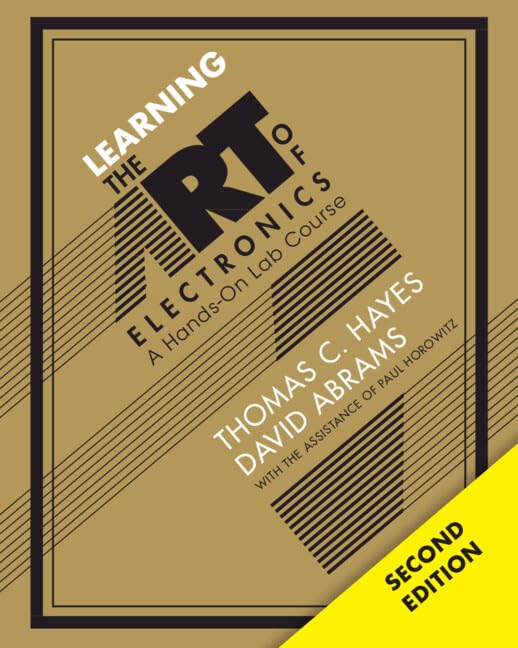
Description:
About this item:
Editorial Reviews
Review:
4.3 out of 5
85.00% of customers are satisfied
5.0 out of 5 stars Possibly The Best Introduction to Hands-on Electronics
(function() { P.when('cr-A', 'ready').execute(function(A) { if(typeof A.toggleExpanderAriaLabel === 'function') { A.toggleExpanderAriaLabel('review_text_read_more', 'Read more of this review', 'Read less of this review'); } }); })(); .review-text-read-more-expander:focus-visible { outline: 2px solid #2162a1; outline-offset: 2px; border-radius: 5px; } This is a way better introduction to working with real electronics than any cookbook or starter kit. Although the full list of components needed to follow along wasn't the easiest to acquire and more expensive than a run-of-the-mill assortment, the selection is diverse and actually covers many functions. Paired with the main text, Art of Electronics, this will leave you with a solid baseline understanding of what the components are and how they work.Very helpful when facing the overwhelmingly massive economy of parts. Light on math and theory; instead focused on component selection. The whole collection compliments any traditional textbook on electronics very well.
5.0 out of 5 stars Excellent Course on Electronics
I have not gotten into the second edition, but I have done the first edition. It was excellent, and the updates to the second edition was exactly what I was hoping would be upgraded in the second edition. As I was going through the first edition I was thinking the digital section was a bit out dated but the second edition appears to have have tackled this problem. I am happy to see the authors are taking active steps in keeping the book in modern times. Truly a great time to be alive. Can't wait to see what this book holds.
5.0 out of 5 stars For ratings, please see the first edition (and this edition is even better)
I rated this five stars -- but I may be biased since I am a co-author of this edition. There aren't any reviews yet since the second edition has only been available for a few weeks. However, you can read reviews of the first edition at https://www.Bolo.com/Learning-Art-Electronics-Hands-Course/dp/0521177235/. This edition improves on the previous one by updating the digital half of the book to include an FPGA (rather than a PAL) and replaces the 8051 with a modern ARM microcontroller programmed in C using a full IDE. It also includes heavy emphasis on finite state machine techniques for both hardware and software design and uses a Real Time Operating System to integrate tasks in the final uController project.
The Art of disappointing readers!
(function() { P.when('cr-A', 'ready').execute(function(A) { if(typeof A.toggleExpanderAriaLabel === 'function') { A.toggleExpanderAriaLabel('review_text_read_more', 'Read more of this review', 'Read less of this review'); } }); })(); .review-text-read-more-expander:focus-visible { outline: 2px solid #2162a1; outline-offset: 2px; border-radius: 5px; } Very disappointed! Who is the book intended for? Having studied Electronics theory from other great books, I wanted to get an insight and guidance to practical lab experience. The authors take too casual an approach in conveying the subject. Throughout the book the topics, explanations and lab exercises feel disconnected. It feels as though I have mistakenly entered a wrong classroom. They spontaneously introduce and refer to terms and topics which would not be mentioned till that point. I can point out numerous such instances. I wonder if the authors have even proofread the text. They have covered a great variety of important topics and content, but it all feels disconnected. The book feels like it is made for people who already have experience of working with electronics, but again the flow of the narration is so inconsistent that even such readers may be left wondering what's happening. Authors tried to make it a book that teaches electronics for a complete beginner, supposedly as an 'art', that fits their own definition. It is neither a textbook, nor a handbook, or a field book. It seems like an experiment with a concoction of a variety of teaching techniques. Two chapters into the book and I already feel I should look for some other book. Definitely not for beginners.
Visit the Cambridge University Press Store
Learning the Art of Electronics: A Hands-On Lab Course
BHD58384
Quantity:
Order today to get by
Free delivery on orders over BHD 20
Product origin: United States
Electrical items shipped from the US are by default considered to be 120v, unless stated otherwise in the product description. Contact Bolo support for voltage information of specific products. A step-up transformer is required to convert from 120v to 240v. All heating electrical items of 120v will be automatically cancelled.
Similar suggestions by Bolo
More from this brand
Similar items from “Circuits”
Share with
Or share with link
https://www.bolo.bh/products/U1009535188